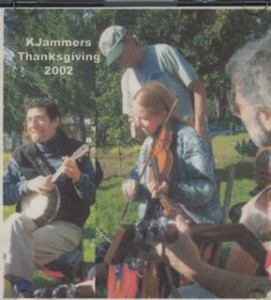[Image: Fiddler Kathrine Gardner, center, with red hair. Husband, Kit, watches over her, Dan Kluger, on Banjo and Banjo Uke, with Mark Kartman on guitar. The photo is from the cover of their CD called “KJammers Thanksgiving 2002”.]
Story by Kathrine Gardner
[This article originally appeared in the early 1990s in “Bay Area Country Dancer”.]
In the fall of 1982 I met someone at a party who dragged me to a San Francisco Folk Music Club outing. From our campsite I heard a far off fiddle tune that beckoned me—I went crashing through the fallen redwood twigs until I saw it: a half dozen people sitting in a circle with fiddles, mandolins and guitars, playing a tune over and over. I had played a lot of music before, but seeing and hearing and feeling that session, I knew THAT was what I had been designed to do. I didn’t know why. But I overwhelmingly desired to be part of it. I didn’t join in then–I had a terrible attack of shyness, and wasn’t even sure if it was O.K. to listen. It had a sacred quality.
Well, I went home to Davis and started taking fiddle lessons immediately (from Barry Shultz who lived there then.) I started to copy not only his music but his life: I bought a car and a tape recorder, quit my job, and started fiddling 4 and 5 hours hours a day. Music festivals and parties became the main reasons for being. I became subject to ecstatic highs and devastating lows. One of the early highs I can remember was actually being able to play along in an old-timey session at Charlie Fenton’s party, along about 1983.
So, to mercifully truncate a long story, here I am, a more or less starving but happy dance musician. Why did I do it? What would make a person forsake a normal life, eschew financial well-being, reject( anything that would take time away from the endless production of pleasing patterns of sound? Because it’s my vehicle for becoming my best self, maybe? I observe that EVERYONE I know who plays music and/or dances seems to grow more wonderful each year. How does this work? I found some good words on it in the Utne Reader (March/April 1992) that I want to share. This is Eric Utne talking about what learning “traditional” art forms does for you.
…My dictionary defines creativity as transcending the traditional…to make something new. This strikes me as a distinctly modernist, Western view. Throughout the East, and in all tribal cultures, the act of embracing and preserving the traditional , especially through ceremony and ritual, is the most creative thing an individual can do. The Karuk Indians of California perform their “ira-hiti” ceremony each September “to fix the world,” that is, to bring the natural forces of the world back into balance. What could be more creative than that?
Instead of trying to create something new and different, something unique,…traditional people seek to harmonize with creation through obedience to natural laws and mastery of the traditional forms—the dance, the song, the painting. They seek not personal self-expression but annihilation of the self and a consequent transmission of a fuller, truer, more complete self…This kind of creativity does not say, “Look at me, look at me.” It says, “Thank you, Lord, thank you….” The end product…is not the point; the process of creating is the point. The act of creating transforms the creator. The creation comes through you, it is not of you.
The way it works is that the whole process of creating music—learning tunes and instruments and playing with people and learning to work with them and love them and make events of music and dance—creates me.
My current view of the creation process is that it has three stages: conceiving something in the mind, feeling the discord between your conception and what currently is, which can release huge amounts of energy, and using that energy to make the thing real. In the context of traditional music, “conceiving” is often just wanting to learn a tune, or an instrument, or a style of playing. It’s no miracle that people devote so much time and effort to learning these things—plenty of energy is generated from the “potential difference” between what you can now do and what you want to be able to do. It sounds as though I could be talking about electricity—a difference of potential causing current to flow. (Maybe it’s all the same thing!?) It’s a sort of energy of desire, like what one feels when one is in love, or (to get back to music) like the need to hear a chord resolve.
The trick is to be able to identify a desire when you have one, and to then let it focus your decisions and actions. Then you will accomplish incredible feats and experience your full human power to create joy. I’m convinced that this amazing, seemingly magical process is our birthright as humans, and is not hard to learn to use once you believe in it. It works for music, art, housework, career planning, entrepreneurship, social change, you name it.
So now that I’m in the midst of an exciting music career, I could also apply these principles to the task of getting less hard-up financially. Hmmm. The trouble is, it won’t work unless I can find a heartfelt desire to do something that would also produce money, in the quantities that seem to be needed to livein this dear Bay Area. So wish me luck. And I’ll see you out there dancing and fiddling.
————-
Kathrine Gardner is a career fiddler who lives in El Granada.
Email Kathrine ([email protected])
650.726.3495

